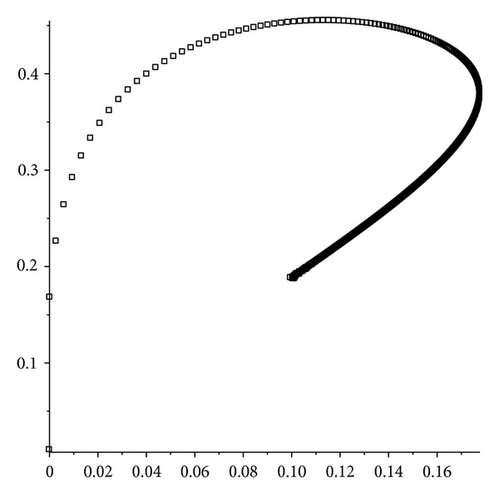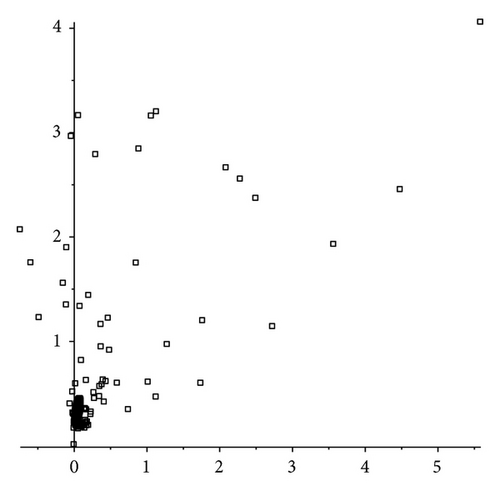On Solutions to Fractional Discrete Systems with Sequential h-Differences
Abstract
We study the subject of a behaviour of the solutions of systems with sequential fractional h-differences. We give formulas for the unique solutions to initial value problems for systems in linear and semilinear cases. Moreover, the sufficient condition that guaranties the positivity of considered systems is presented.
1. Introduction
The first definition of the fractional derivative was introduced by Liouville and Riemann at the end of the 19th century. Later on, in the late 1960s, this idea was used by engineers for modeling various processes. Thus the fractional calculus started to be exploited since that time. This calculus is a field of mathematics that grows out of the traditional definitions of integrals, derivatives, and difference operators and deals with fractional integrals, derivatives, and differences of any order. Many authors prove that fractional differential and difference equations are more adequate for modeling physical and chemical processes than integer-order equations. Fractional differential and difference equations describe many phenomena arising in engineering, physics, economics, and science. In fact, several applications can be found in viscoelasticity, electrochemistry, electromagnetic, and so forth. For example, Machado [1] gave a novel method for the design of fractional order digital controllers. Fractional difference calculus has been investigated by many authors, for example, [2–12] and others. In particular, different delta and nabla type fractional differences have been studied in [13–15], where the authors relate these differences by deriving some dual identities. The calculus of fractional h-differences was given, for instance, in [5, 10, 16–19]. The properties of systems defined by the fractional difference equations where studied, for example, in [20–24]. There exist definitions of sequential operators in continuous case with different types of derivatives like Caputo type, Riemann-Liouville type, and Hadamard type, see, for example, [9, 12, 25–27]. In parallel with this paper we developed the theory of fractional h-differences with sequential operators in the paper [28], where the approximation of continuous fractional sequential derivative is considered. We compute different formulas of solutions and then we try to check the system′s behaviour, precisely the positivity of solutions. As far as we know the subject of positivity is well developed for fractional linear systems with continuous time; see [8, 29–32]. However, positivity of fractional discrete systems with sequential h-differences is still a field to be examined. In the present paper we open our studies in this field. We give formulas for the unique solutions to initial problems for systems in linear and semilinear cases. Moreover, the positivity of systems with sequential h-differences is considered. We consider systems with sequential h-differences of Caputo type, while in [32] systems with Grünwald-Letnikov operator are studied. It is worth to add that in [32] (and references within) the considered systems are not of sequential type. Additionally, we have the exact formulas of the solutions of the systems both with the sequential differences and with the ordinary differences while in [32] the recurrence form of solution for discrete systems with Grünwald-Letnikov difference is given.
The paper is organized as follows. In Section 2 all preliminary definitions, facts, and notations are gathered. Section 3 presents systems with sequential fractional differences with results on uniqueness of solutions. We include semilinear systems in Section 4. The Section 5 concerns positivity of considered systems. Finally, the illustrative example is presented.
2. Preliminaries
Definition 1. For a function the forward h-difference operator is defined as
Definition 2. For arbitrary α ∈ ℝ the h-factorial function is defined by
Proposition 3 (see [12].)Let α ∈ ℝ.
- (1)
For j ∈ ℕ0 one has , where α, j are such that both sides are well defined;
- (2)
For n ∈ ℕ0 one has ;
- (3)
For k ∈ ℕ1 one has .
The next definition with another notation was stated in [17]. Here we use more suitable summations.
Definition 4. For a function the fractional h-sum of order α > 0 is given by
It is important to notice that the operator changes the domains of functions.
Remark 5. Note that .
According to the definition of h-factorial function the formula given in Definition 4 can be rewritten as
Remark 6. In [7] one can find the following form of the fractional h-sum of order α > 0:
The following definition can be found in [33] for h = 1 or in [10] for an arbitrary h > 0.
Definition 7. Let α ∈ (0,1]. The Caputo h-difference operator of order α for a function is defined by
Remark 8. Note that , where α ∈ (0,1].
Definition 9. For α, β > 0 we define
Remark 10. It is worthy to notice that for n ∈ ℕ0
- (a)
φ0,0(nh) = 1;
- (b)
and the values are neglected for n = 0;
- (c)
φk,s((n − l)h) = (Γ(n − l + 1 + kα + sβ))/(Γ(kα + sβ + 1)Γ(n − l + 1)) and as the division by pole gives zero, the formula works also for n < l, l ∈ ℕ0;
- (d)
, l ∈ ℕ0.
We also need the following proposition.
Proposition 11. Let α, β ∈ (0,1], h > 0 and a = (α − 1)h, b = (β − 1)h. Then for n ∈ ℕl+1, l ∈ ℕ0
Proof. We show only equality (15), as (16) is a symmetric one.
Let μ : = kα + sβ. For r ∈ (hℕ) lh we define the following h-factorial function . Since
From the application of the power rule follows the rule for composing two fractional h-sums. The proof for the case h = 1 can be found in [7]. For any positive h > 0 the proof is presented in [10].
Proposition 12. Let x be a real valued function defined on (hℕ)a, where a, h ∈ ℝ, h > 0. For α, β > 0 the following equalities hold:
where t ∈ (hℕ)a+(α+β)h.
The next proposition gives a useful identity of transforming Caputo fractional difference equations into fractional summations for the case when an order is from the interval (0,1].
Proposition 13 (see [10].)Let α ∈ (0,1], h > 0, a = (α − 1)h and let x be a real valued function defined on (hℕ)a. The following formula holds:
The operators presented above can be extended to vectors in a componentwise manner.
3. Solutions of Systems with Sequential Fractional Differences
Firstly we prove the formula for the unique solution in linear case of (23) and (24): f(nh, x(nh + a)) = Ax(a + nh), where A is a constant square matrix of degree n.
Theorem 14. The solution to the system
Proof. Notice that for n = 0 we get x(a + 0 · h) = A0(φ0,0(0)xa + φ1,0(−h)x0). Since φ0,0(0) = 1 and φ1,0(−h) = 0, we get x(a + 0 · h) = xa.
For n > 0 let us define the sequence in the following way:
We calculate the first step. As , then g0(nh) = Axa( 0Δ−β1)(b + nh) = Axaφ0,1((n − 1)h). Going further,
Taking m tending to +∞ we get formula (41) as the solution of (39) and (40) with initial conditions (25) and (26).
3.1. Semilinear Sequential Systems
Firstly we state a technical lemma and notations.
Lemma 15. Let γ : (hℕ) 0 → ℝ and α > 0. Let and for k ∈ ℕ1. Then for k ∈ ℕ1 one gets
Proof. First let us consider the case k = 1. Then from Proposition 12 we can write
Let and . Then
Theorem 16. The solution to the system
Proof. Note that φ0,0(0) = 1, φ1,0(−h) = 0 and φk+1,k+1(−h) = 0 for k ≥ 0, so we get x(a + 0h) = xa.
For n > 0 based on the proof for linear case we can write the solution formula as follows:
4. Positivity
Let be the set of real N × M matrices with the nonnegative entries and .
Based on [8, 31, 32] we consider the following definitions.
Definition 17. The fractional system (23) and (24) is called positive fractional system if and only if for any initial conditions .
Similarly as in [32] we will use the recursive formula (35) to show the positivity of the considered systems. Observe that the systems considered in this paper are of the sequential type while in [32] the sequential systems are not studied. Moreover, the Grünwald-Letnikov operator with the step equal to one is used in [32], whereas we study the systems with the h-differences of Caputo type. So in our case the steps are equal to h.
From [32] we have the following lemma.
Lemma 18. If 0 < α < 1, then , i = 1,2, 3, ….
Moreover, for k ≥ 3 we have .
Proposition 19. Let 0 < α + β ≤ 1. If and for all n ≥ 0,
Proof. The proof is by the induction principle. Assume that 0 < α + β ≤ 1 and both α > 0 and β > 0. Since and h > 0, by (35) we have
Corollary 20. Let 0 < α + β ≤ 1 and IN denote the identity matrix. If and for all n ≥ 1,
Remark 21. In [32] the sufficient condition concerning the positivity of the linear discrete systems with Grünwald-Letnikov operator is as follows: . In our case since we have systems with the sequential fractional h-difference, in our condition h and both orders α and β appear. Note that taking h = 1 the sufficient condition (71) has the form .
Let us now consider some examples that illustrate the solution of the considered systems.
Example 22. Let N = 2, α = 0.4, β = 0.5 and h = 0.01. Then let us take a = −0.006 and b = −0.005 and consider the linear system with sequential difference in the following form:


5. Conclusions
The behaviour of the solutions of systems with sequential fractional difference is studied. We present recursive formulas for nonlinear systems and give the exact formulas for the unique solutions to systems in linear and semilinear cases. We prove the sufficient condition for the positivity of considered systems.
Our future goal is to study stability of systems with sequential fractional differences.
Acknowledgments
This project was supported by the foundayion of the National Science Centre granted on the bases of the decision. The DEC-2011/03/B/ST7/03476. This work was supported by Bialystok University of Technology Grant no. G/WM/3/2012.




